
Beautiful telescopic image of comet 46P/Wirtanen, taken November 4, 2018, with an 11-inch telescope by Martin Mobberley. The image shows the development of a gas tail for the comet. Used with permission.
Have you heard about comet 46P/Wirtanen? It’s due to pass closest to our sun and Earth in December 2018. Comet Wirtanen is the brightest comet in the night sky now, visible not with the eye alone, but to astronomers with telescopes and binoculars. In December 2018, comet Wirtanen might indeed become visible to the eye, at least from dark locations. Wirtanen’s closest approach to the sun will be December 12, 2018, and its closest approach to Earth is just a few days later, on December 16. You’ll find some charts, and info on how to see it, below.
As of late November, observers around the world are reporting that Comet 46P/Wirtanen is showing a brightness or visual magnitude between 5.5 to 6.5. That is on the cusp of visibility to the eye, in theory. However, the dim light reflected from comet Wirtanen is spread over a large cometary atmosphere.
This may mean that – as December arrives, the month in which the comet should look brightest from Earth – Wirtanen may look more diffuse and harder to see than expected. As the comet may not be easily visible for casual observers, a good option would be to verify if your local astronomy club will be hosting events for observing comet 46P/Wirtanen.
Also, in November 2018, astronomers reported capturing a new image of comet Wirtanen, showing gas spirals as the comet rotates. See the image.
The 2019 lunar calendars are here! Order yours before they’re gone. Makes a great gift.
Pablo Goffard in Valle del Elqui, Coquimbo, Chile captured Comet Wirtanen on November 7, 2018. 130 mm Newton Telescope, Canon T3.
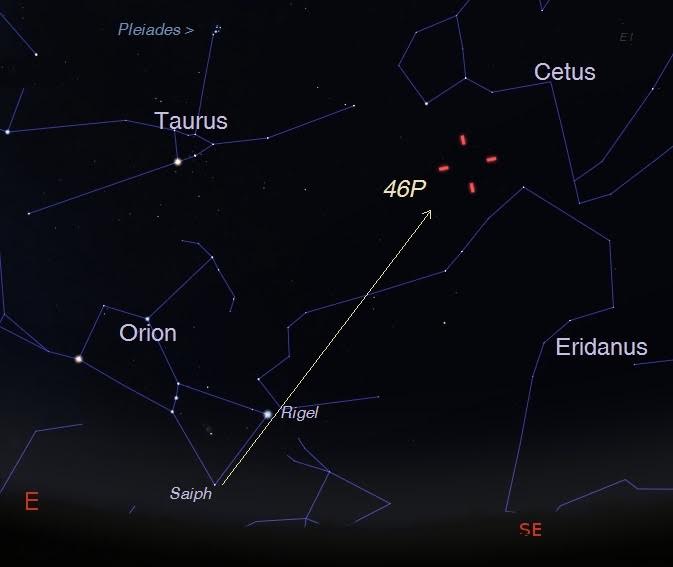
Comet Wirtanen on December 8, 2018, shortly after nightfall. Illustration by Eddie Irizarry using Stellarium.
How close will comet Wirtanen come?
According to astronomers at the University of Maryland, this passage of comet Wirtanen near the Earth (near by comet standards, that is) will be the 10th closest approach of a comet in modern times.
At its closest to us, the comet will be about 30 times the moon’s distance (7.1 million miles, or 11.5 million km).
The record for the closest observed comet – for all of recorded history – goes to D/1770 L1 Lexell, which came at less than 6 times the Earth-moon distance in June, 1770.
Or, contrast Wirtanen’s closest appraoch – 30 times the moon’s distance, 7.1 million miles, or 11.5 million km – to another comet that swept relatively near us recently, 21P/Giacobini-Zinner, causing a brief outburst in this year’s Draconid meteor shower. Giacobini-Zinner swept closest to Earth on September 9-10, 2018, at 36 million miles (58 million km). That was the closest Giacobini-Zinner had come in 72 years!
So you see comets are elusive objects. They don’t come very close, usually, in any absolute sense. Still, this 2018 approach is a good one for comet Wirtanen. To understand why, you have to think of the comet, and Earth, in their orbits.
Comet Wirtanen belongs to the Jupiter family of comets. Its orbit brings the comet just outside of Earth’s orbit, to just inside of Jupiter’s path around the sun. Although it orbits our sun every 5.4 years, the 2018 pass is its closest since its discovery some 70 years ago by American astronomer Carl A. Wirtanen on January 17, 1948.
Since its discovery, the comet has approached Earth’s orbit a dozen times. However, as it happens, each time it swept in near our planet’s orbit, Earth was on the far side of the orbit, as seen in the following illustration:

A close approach of a comet depends in part on where the comet is, and in part on where Earth is, when the 2 bodies sweep closest. This illustration shows the approach of comet Wirtanen to Earth’s orbit in July, 2013. At that time, Earth was on the other side of its orbit from the comet, so the approach was not particularly close. Image via astro.vanbuitenen.nl.
Not so in 2018. At the 2018 encounter, the comet and Earth will be on the same side of Earth’s orbit, when the closest approach occurs:
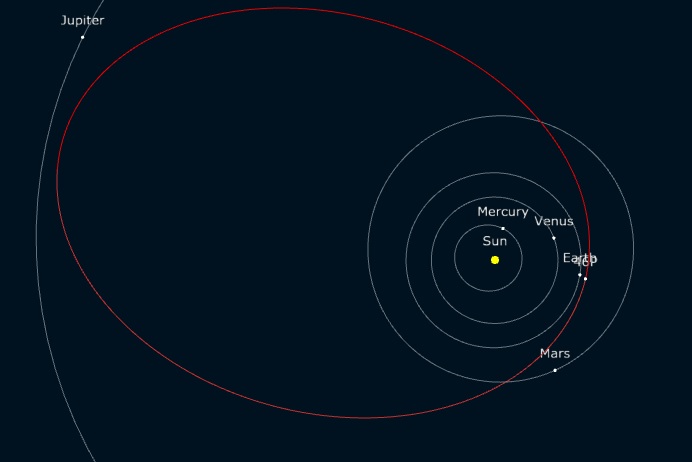
The 2018 approach of comet 46P/Wirtanen is the comet’s closest since its discovery in 1948. Image via astro.vanbuitenen.nl.
How bright will the comet get? No one knows for certain. Comets are unpredictable by their nature. Estimates indicate Wirtanen might reach a visual magnitude of 3.5 to 6. That would place the comet clearly in the realm of visibility with the unaided eye (although diffuse objects like comets are tougher to see than the pinpoints of stars at comparable magnitudes).
Want to stay up-to-date on Wirtanen’s brightness? University of Maryland astronomers are providing updates on its current brightness.
The image below provides a mixture of observations so far – and predictions – for the brightness of comet Wirtanen when closest to Earth in December, 2018:
This is what’s called a lightcurve. It’s a measurement of comet 46P/Wirtanen’s brightness over time. Lightcurve (colored dots) compiled from observations reported to the Minor Planet Center1 (solid circles) and the Comet Observer’s Database2 (open circles). Predicted magnitudes are current estimates from sources using different techniques, and have a wide variability. For more information about these predictions, see the Wirtanen brightness discussion. Image via University of Maryland’s comet 46P/Wirtanen: current status page.
How can you see comet Wirtanen?
And, most importantly, will this comet be visible with the unaided eye? Some observers are already glimpsing the celestial visitor using binoculars. In early November, Wirtanen had a visual magnitude of 8, making it the brightest comet in our skies for the moment, but still not visible to the unaided eye.
By mid December, 46P/Wirtanen might reach a magnitude of 3.5 to 6, perhaps visible to the unaided eye as a faint, diffuse object from dark skies.
Here’s how to understand stellar magnitude
In December, binoculars and small telescopes should show a diffuse cometary atmosphere, which might appear considerably large for an object whose icy cometary nucleus, or core, is less than a mile (just 1.2 km) wide.
Will the comet show a tail? Due to the orientation in space of Earth and Wirtanen when the comet is closest, the ion tail will be behind the comet, not visible from Earth’s perspective. If 46P/Wirtanen develops a slight curved tail in the coming weeks, it should be barely detectable, easier to see in astrophotography than with the unaided eye.
Again – always – expect to get the best views and contrast through binoculars or a telescope, in a dark sky location, far from city lights.
No telescope or binoculars? Consider watching the comet online. On December 12 and 17, 2018 (around the closest approach of the comet to the sun and Earth), the Virtual Telescope Project will be showing comet Wirtanen live, online, for free. Click here for more information, and check out their poster for this event, below:
Visit the Virtual Telescope Project for a free, online viewing of comet Wirtanen on December 12 and 17.
So comet 46P/Wirtanen might – or might not – meet your expectations. As always, if you take the time to watch it over some weeks, you’ll appreciate it more. There are some nice details here to appreciate.
For example, as you gaze at the comet, realize that its cometary atmosphere – or coma – is bigger, in an absolute sense, than the planet Jupiter.
As for how big the coma will appear in our sky … some estimates suggest it might be as big as the apparent diameter of the moon! Maybe even bigger. Since the outer area of this dim coma will be the faintest, astrophotography will be the best way of detecting how big it really is, especially by mid December.
Also, if you have optical aid, you might be able to discern this comet’s movement in front of the stars. In early November, the comet was approaching Earth at 21,251 miles per hour (34,200 km/h), or 9.5 km/s. By December, as the comet gets closer to us, Wirtanen will appear to gain speed. Careful observations of the comet – in particular with a small telescope – should let you perceive its motion relative to the stars, over about a 30-minute period.
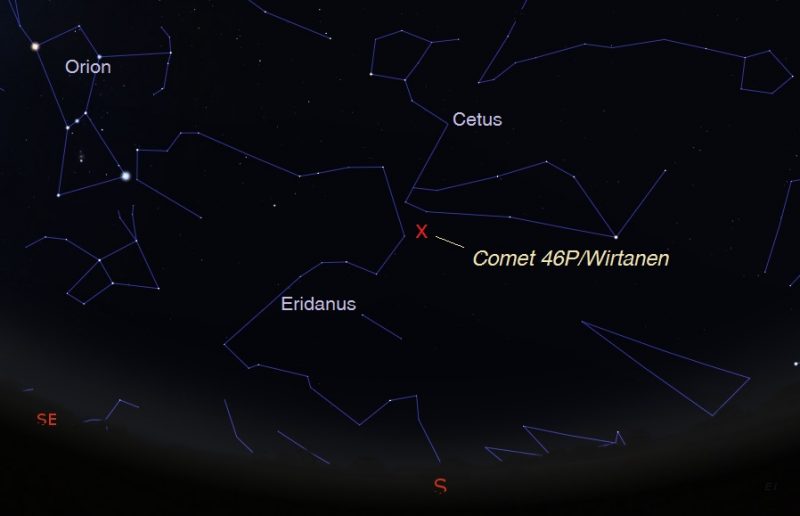
Location of comet 46P/Wirtanen on December 1, 2018, as seen from central U.S. around 9 p.m., facing south. Illustration by Eddie Irizarry using Stellarium.
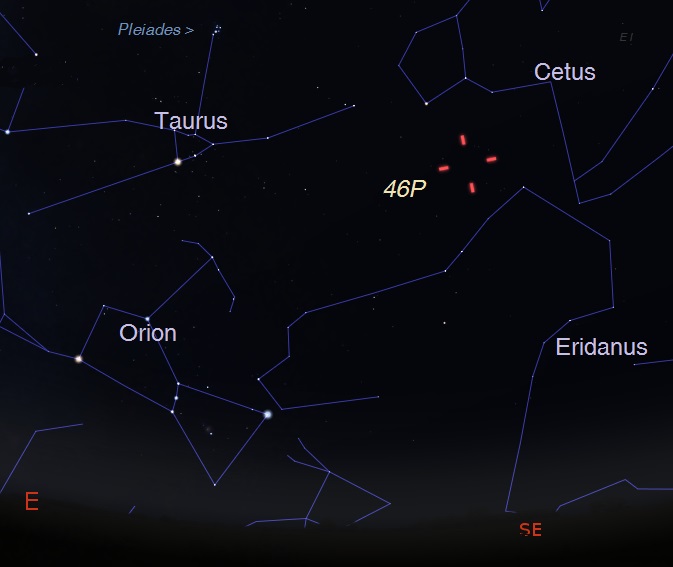
On December 8, 2018, comet 46P/Wirtanen should be easier to locate. Note that stars Saiph and Rigel (on the right side of Orion) point to the comet. Also, the celestial visitor should be slightly brighter by then. This view shows the sky as seen from central U.S. shortly after nightfall on December 8, facing southeast. Illustration by Eddie Irizarry using Stellarium.
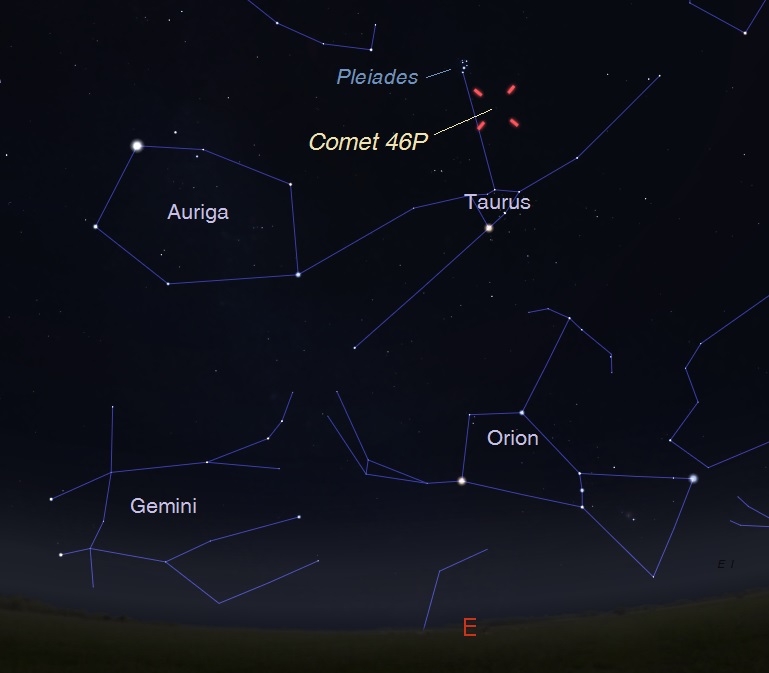
The night of December 15, 2018, may provide your best views of comet 46P/Wirtanen. First, look at the familiar stars of Orion, then look up to the stars that compose the Pleiades cluster in Taurus. By mid December, the comet is located very close to this easy-to-find group of stars. Facing east, shortly after nightfall. Illustration by Eddie Irizarry using Stellarium.
And there is more…
By early December, sky enthusiasts observing comet 46P/Wirtanen with telescopes will occasionally see one or more slow-moving objects entering the same field of view as the comet. These objects will appear so slow, that they will look like asteroids. However, these are not space rocks. They are human-made satellites.
Between December 6 and 12, 2018, comet 46P/Wirtanen enters an area of the sky where, as seen from our perspective, there is an orbiting ring of some 450 active geostationary satellites.
The belt of meteorological, television and other communication satellites orbit our planet at about 22,236 miles (35,786 km) above Earth’s equator. As these satellites orbit our planet at the same speed that Earth rotates, geostationary satellites appear to be motionless, at a fixed position in the sky, thus explaining why the small satellite dishes on the roof of our houses are pointing at a fixed position.
Because they orbit so high above Earth, these satellites are illuminated by the sun most of the time.
Observers using telescopes with a small motor that tracks astronomical objects in the sky, compensating for the Earths’ rotation, will perceive the slow motion of these satellites passing in front of the comet and stars. The view will be similar to the one seen on this video:
If the object appears to cross the field of view in the telescope fairly fast, you are likely looking at a satellite in low-Earth orbit. But if the satellite is moving slowly and remains visible several seconds through the telescope, you are probably seeing one of many geostationary satellites that will be visible in the path of comet Wirtanen from early to mid-December.
Sometimes, geostationary satellites may be visible in groups of 3 or more.
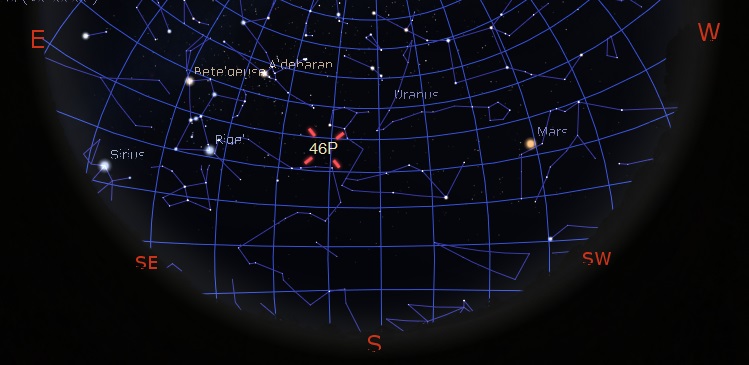
The line that crosses from east to west is the celestial equator as seen from the Northern Hemisphere. From our perspective, comet Wirtanen appears to enter the belt of geostationary satellites between December 6 to 12. If you are looking from a location north of the equator, then there is a slight perspective difference or parallax of objects in space, so these satellites are seen slightly south of the celestial equator, as seen from the U.S.
Can you confirm you are looking at a geostationary satellite at the eyepiece? Yes. If you are a using a computerized or tracking telescope, center the slow-moving object in the field of view. Then turn off the telescope or tracking function. If it’s a geostationary satellite, it will remain centered and now all the stars will appear to slowly drift as Earth rotates.
Keep in mind that you might have to re-align the telescope to continue observing the comet or other astronomical objects. Have fun!
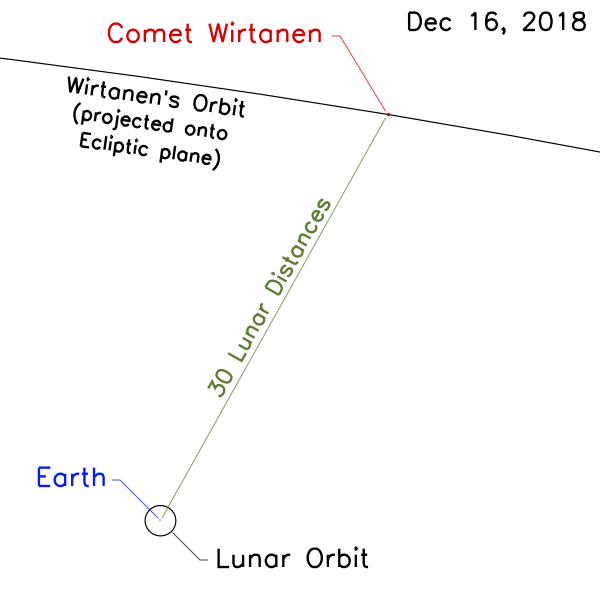
The December 16, 2018, close approach to Earth of comet Wirtanen will happen less than 4 days after the comet’s perihelion, or closest point to the sun. Because comets are increasingly active as they draw nearer the sun that binds them in orbit, this comet can be expected to be near its brightest around then. It might be visible to the eye from a dark location. Image via University of Maryland.
Bottom line: Comet Wirtanen will come closest to Earth in December. Comets are unpredictable, but it seems this one might at least offer good binocular views, and it’ll possibly be visible to the eye. Will it be more interesting than just a diffuse coma ball? Let’s see what’s in store for us!
from EarthSky https://ift.tt/2OYXKeL

Beautiful telescopic image of comet 46P/Wirtanen, taken November 4, 2018, with an 11-inch telescope by Martin Mobberley. The image shows the development of a gas tail for the comet. Used with permission.
Have you heard about comet 46P/Wirtanen? It’s due to pass closest to our sun and Earth in December 2018. Comet Wirtanen is the brightest comet in the night sky now, visible not with the eye alone, but to astronomers with telescopes and binoculars. In December 2018, comet Wirtanen might indeed become visible to the eye, at least from dark locations. Wirtanen’s closest approach to the sun will be December 12, 2018, and its closest approach to Earth is just a few days later, on December 16. You’ll find some charts, and info on how to see it, below.
As of late November, observers around the world are reporting that Comet 46P/Wirtanen is showing a brightness or visual magnitude between 5.5 to 6.5. That is on the cusp of visibility to the eye, in theory. However, the dim light reflected from comet Wirtanen is spread over a large cometary atmosphere.
This may mean that – as December arrives, the month in which the comet should look brightest from Earth – Wirtanen may look more diffuse and harder to see than expected. As the comet may not be easily visible for casual observers, a good option would be to verify if your local astronomy club will be hosting events for observing comet 46P/Wirtanen.
Also, in November 2018, astronomers reported capturing a new image of comet Wirtanen, showing gas spirals as the comet rotates. See the image.
The 2019 lunar calendars are here! Order yours before they’re gone. Makes a great gift.
Pablo Goffard in Valle del Elqui, Coquimbo, Chile captured Comet Wirtanen on November 7, 2018. 130 mm Newton Telescope, Canon T3.

Comet Wirtanen on December 8, 2018, shortly after nightfall. Illustration by Eddie Irizarry using Stellarium.
How close will comet Wirtanen come?
According to astronomers at the University of Maryland, this passage of comet Wirtanen near the Earth (near by comet standards, that is) will be the 10th closest approach of a comet in modern times.
At its closest to us, the comet will be about 30 times the moon’s distance (7.1 million miles, or 11.5 million km).
The record for the closest observed comet – for all of recorded history – goes to D/1770 L1 Lexell, which came at less than 6 times the Earth-moon distance in June, 1770.
Or, contrast Wirtanen’s closest appraoch – 30 times the moon’s distance, 7.1 million miles, or 11.5 million km – to another comet that swept relatively near us recently, 21P/Giacobini-Zinner, causing a brief outburst in this year’s Draconid meteor shower. Giacobini-Zinner swept closest to Earth on September 9-10, 2018, at 36 million miles (58 million km). That was the closest Giacobini-Zinner had come in 72 years!
So you see comets are elusive objects. They don’t come very close, usually, in any absolute sense. Still, this 2018 approach is a good one for comet Wirtanen. To understand why, you have to think of the comet, and Earth, in their orbits.
Comet Wirtanen belongs to the Jupiter family of comets. Its orbit brings the comet just outside of Earth’s orbit, to just inside of Jupiter’s path around the sun. Although it orbits our sun every 5.4 years, the 2018 pass is its closest since its discovery some 70 years ago by American astronomer Carl A. Wirtanen on January 17, 1948.
Since its discovery, the comet has approached Earth’s orbit a dozen times. However, as it happens, each time it swept in near our planet’s orbit, Earth was on the far side of the orbit, as seen in the following illustration:

A close approach of a comet depends in part on where the comet is, and in part on where Earth is, when the 2 bodies sweep closest. This illustration shows the approach of comet Wirtanen to Earth’s orbit in July, 2013. At that time, Earth was on the other side of its orbit from the comet, so the approach was not particularly close. Image via astro.vanbuitenen.nl.
Not so in 2018. At the 2018 encounter, the comet and Earth will be on the same side of Earth’s orbit, when the closest approach occurs:

The 2018 approach of comet 46P/Wirtanen is the comet’s closest since its discovery in 1948. Image via astro.vanbuitenen.nl.
How bright will the comet get? No one knows for certain. Comets are unpredictable by their nature. Estimates indicate Wirtanen might reach a visual magnitude of 3.5 to 6. That would place the comet clearly in the realm of visibility with the unaided eye (although diffuse objects like comets are tougher to see than the pinpoints of stars at comparable magnitudes).
Want to stay up-to-date on Wirtanen’s brightness? University of Maryland astronomers are providing updates on its current brightness.
The image below provides a mixture of observations so far – and predictions – for the brightness of comet Wirtanen when closest to Earth in December, 2018:
This is what’s called a lightcurve. It’s a measurement of comet 46P/Wirtanen’s brightness over time. Lightcurve (colored dots) compiled from observations reported to the Minor Planet Center1 (solid circles) and the Comet Observer’s Database2 (open circles). Predicted magnitudes are current estimates from sources using different techniques, and have a wide variability. For more information about these predictions, see the Wirtanen brightness discussion. Image via University of Maryland’s comet 46P/Wirtanen: current status page.
How can you see comet Wirtanen?
And, most importantly, will this comet be visible with the unaided eye? Some observers are already glimpsing the celestial visitor using binoculars. In early November, Wirtanen had a visual magnitude of 8, making it the brightest comet in our skies for the moment, but still not visible to the unaided eye.
By mid December, 46P/Wirtanen might reach a magnitude of 3.5 to 6, perhaps visible to the unaided eye as a faint, diffuse object from dark skies.
Here’s how to understand stellar magnitude
In December, binoculars and small telescopes should show a diffuse cometary atmosphere, which might appear considerably large for an object whose icy cometary nucleus, or core, is less than a mile (just 1.2 km) wide.
Will the comet show a tail? Due to the orientation in space of Earth and Wirtanen when the comet is closest, the ion tail will be behind the comet, not visible from Earth’s perspective. If 46P/Wirtanen develops a slight curved tail in the coming weeks, it should be barely detectable, easier to see in astrophotography than with the unaided eye.
Again – always – expect to get the best views and contrast through binoculars or a telescope, in a dark sky location, far from city lights.
No telescope or binoculars? Consider watching the comet online. On December 12 and 17, 2018 (around the closest approach of the comet to the sun and Earth), the Virtual Telescope Project will be showing comet Wirtanen live, online, for free. Click here for more information, and check out their poster for this event, below:
Visit the Virtual Telescope Project for a free, online viewing of comet Wirtanen on December 12 and 17.
So comet 46P/Wirtanen might – or might not – meet your expectations. As always, if you take the time to watch it over some weeks, you’ll appreciate it more. There are some nice details here to appreciate.
For example, as you gaze at the comet, realize that its cometary atmosphere – or coma – is bigger, in an absolute sense, than the planet Jupiter.
As for how big the coma will appear in our sky … some estimates suggest it might be as big as the apparent diameter of the moon! Maybe even bigger. Since the outer area of this dim coma will be the faintest, astrophotography will be the best way of detecting how big it really is, especially by mid December.
Also, if you have optical aid, you might be able to discern this comet’s movement in front of the stars. In early November, the comet was approaching Earth at 21,251 miles per hour (34,200 km/h), or 9.5 km/s. By December, as the comet gets closer to us, Wirtanen will appear to gain speed. Careful observations of the comet – in particular with a small telescope – should let you perceive its motion relative to the stars, over about a 30-minute period.

Location of comet 46P/Wirtanen on December 1, 2018, as seen from central U.S. around 9 p.m., facing south. Illustration by Eddie Irizarry using Stellarium.

On December 8, 2018, comet 46P/Wirtanen should be easier to locate. Note that stars Saiph and Rigel (on the right side of Orion) point to the comet. Also, the celestial visitor should be slightly brighter by then. This view shows the sky as seen from central U.S. shortly after nightfall on December 8, facing southeast. Illustration by Eddie Irizarry using Stellarium.

The night of December 15, 2018, may provide your best views of comet 46P/Wirtanen. First, look at the familiar stars of Orion, then look up to the stars that compose the Pleiades cluster in Taurus. By mid December, the comet is located very close to this easy-to-find group of stars. Facing east, shortly after nightfall. Illustration by Eddie Irizarry using Stellarium.
And there is more…
By early December, sky enthusiasts observing comet 46P/Wirtanen with telescopes will occasionally see one or more slow-moving objects entering the same field of view as the comet. These objects will appear so slow, that they will look like asteroids. However, these are not space rocks. They are human-made satellites.
Between December 6 and 12, 2018, comet 46P/Wirtanen enters an area of the sky where, as seen from our perspective, there is an orbiting ring of some 450 active geostationary satellites.
The belt of meteorological, television and other communication satellites orbit our planet at about 22,236 miles (35,786 km) above Earth’s equator. As these satellites orbit our planet at the same speed that Earth rotates, geostationary satellites appear to be motionless, at a fixed position in the sky, thus explaining why the small satellite dishes on the roof of our houses are pointing at a fixed position.
Because they orbit so high above Earth, these satellites are illuminated by the sun most of the time.
Observers using telescopes with a small motor that tracks astronomical objects in the sky, compensating for the Earths’ rotation, will perceive the slow motion of these satellites passing in front of the comet and stars. The view will be similar to the one seen on this video:
If the object appears to cross the field of view in the telescope fairly fast, you are likely looking at a satellite in low-Earth orbit. But if the satellite is moving slowly and remains visible several seconds through the telescope, you are probably seeing one of many geostationary satellites that will be visible in the path of comet Wirtanen from early to mid-December.
Sometimes, geostationary satellites may be visible in groups of 3 or more.

The line that crosses from east to west is the celestial equator as seen from the Northern Hemisphere. From our perspective, comet Wirtanen appears to enter the belt of geostationary satellites between December 6 to 12. If you are looking from a location north of the equator, then there is a slight perspective difference or parallax of objects in space, so these satellites are seen slightly south of the celestial equator, as seen from the U.S.
Can you confirm you are looking at a geostationary satellite at the eyepiece? Yes. If you are a using a computerized or tracking telescope, center the slow-moving object in the field of view. Then turn off the telescope or tracking function. If it’s a geostationary satellite, it will remain centered and now all the stars will appear to slowly drift as Earth rotates.
Keep in mind that you might have to re-align the telescope to continue observing the comet or other astronomical objects. Have fun!

The December 16, 2018, close approach to Earth of comet Wirtanen will happen less than 4 days after the comet’s perihelion, or closest point to the sun. Because comets are increasingly active as they draw nearer the sun that binds them in orbit, this comet can be expected to be near its brightest around then. It might be visible to the eye from a dark location. Image via University of Maryland.
Bottom line: Comet Wirtanen will come closest to Earth in December. Comets are unpredictable, but it seems this one might at least offer good binocular views, and it’ll possibly be visible to the eye. Will it be more interesting than just a diffuse coma ball? Let’s see what’s in store for us!
from EarthSky https://ift.tt/2OYXKeL

Aucun commentaire:
Enregistrer un commentaire